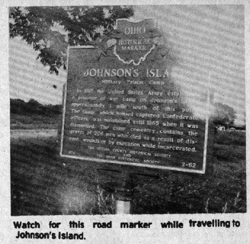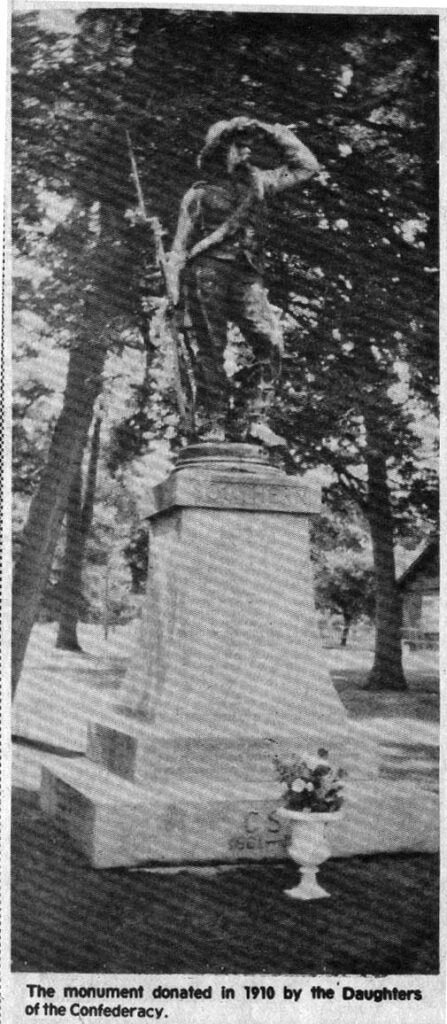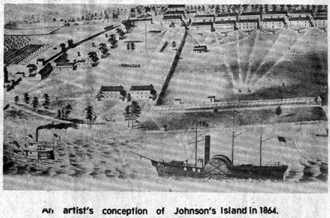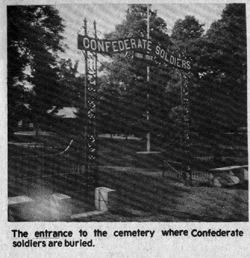September 4, 1980




Picture #1 – Watch for this road marker while travelling to Johnson’s Island.
Picture #2 – The entrance to the cemetery where Confederate soldiers are buried.
Picture #3 – An artist’s conception of Johnson’s Island in 1864.
Johnson’s Island Prison Camp for Confederate soldiers, subject of today’s article, is a sequel to an earlier Potluck article about the Confederate prison at Andersonville for Union soldiers.
All Confederate prisons may not have been as disgraceful as Andersonville, where 13,669 marked graves are reminders of those Union soldiers who died of disease and malnutrition.
The prison camp at Johnson’s Island seems to have been a much better facility for holding Southern soldiers, but was only one of a number of Union prisons, some of which may not have been as well maintained. Johnson’s Island camp was one of two in Ohio, the other being at Camp Chase, Columbus.
Johnson’s Island was 300 acres, located in Sandusky Bay, adjacent by a causeway. In 1861, when the U.S. Government leased the island for use as a prison camp, it could only be reached by boat, which made it ideal as a prison.
206 BURIED THERE
The accompanying illustration is an artist’s conception of how the prison camp looked in 1864, with the various facilities for confinement of the 15,000 prisoners who were lodged there throughout the Civil War. In the upper left hand corner of that illustration can be seen the cemetery were 206 of the southern soldiers who died there are buried.
Most of the prisoners on Johnson’s Island were officers in the Confederate Army, with markers for the exceptions are marked “Private”.
I presume primarily officers were confined to the Lake Erie island prison because it provided maximum security, being surrounded by water.
Earlier in this article, it was mentioned that Johnson’s Island Prison was substantially better than Andersonville. Even though it offered ample water, shelter, and food, the book “Scraps From the Prison Table” by Joe Barbierra, Lt. Col., a Confederate confined there, enumerate various conditions and incidents enacted there which might not give it an “A”.
MISTREATMENT COMMON
“Captain Meadows, of the First Alabama Regiment, while passing within the line of stakes, (laid by our captors) and totally unconscious of any dander, was shot and badly wounded in the leg, by a buckshot, discharged by a cowardly sentinel on the wall; the wound severe but not dangerous”.
Breakfast, six a.m., tin cup of water and coffee, and a piece, too frequently of sour bread, in a tin plate, and the boiled meat of the day before.
This the 26th day of June, 1862, and as per the daily Sandusky papers, the Island Queen” would, with a gay party, steam around the bay slowly, so as to give a fine view of the prisoners quarters. She is now passing; crowded with both sexes viewing with each other in displaying their contempt for prisoners…to be gazed at by a vulgar rabble, as if we were caged hyenas.
This later quote is ironic, considering that many of the Confederate officers confined at the prison came from fine Southern homes, and all of them belonged to the Masonic Lodge, according to one of the monuments which can be seen by visitors who may visit the cemetery in this day.
The book presents many other instances of cruelty by the captors to their American brothers in attempts to shoot them down on pretense of anticipated escape from the island.
An aged mother comes one thousand miles to see her darling boy, a mere youth, who will be exchanged in a few days, and it is possibly the last opportunity he may have on earth, of receiving a mother’s blessing. The mother prays to the relentless fiend in charge of us, to see her son for but one moment, but it is denied.
It seems ironic that such mistreatment, by either the North or South could have been possible, but it is proof that human nature becomes uncertain when governed by hatred and misunderstanding, even by professing Christians.
CONSPIRACY PLOTTED
In the fall of 1864, a conspiracy was concocted to release the Confederate prisoners on Johnson’s Island, numbering about 2,500 at that time, and 5,000 at Camp Chase.
The object first was to capture the only armed vessel on the Great Lake, the USS Michigan, a gun-boat carrying 18 guns, stationed in Sandusky Bay.
A railroad train then was to be seized for a fast run to Columbus to release the Camp Chase prisoners. The two groups of prisoners were to be formed into a hastily organized army, with ranking officers from the island prison in command.
Returning to Sandusky, the leaders were to capture Sandusky and establish it as headquarters of the Confederate forces. Assigned as agents to carry out the scheme were Captain Charles H. Cole, of General Bedford Forrest’s Calvary and Captain John Yates Beall, of the Confederate Navy.
Captain Cole appeared in Sandusky during the early summer of 1864, representing himself to be the secretary of the Mount Hope Oil Company in Titusville, Pa. Attaining social standing he became friend of the officers of the Michigan.
A similar association grew with the federal officers commanding Johnson’s Island where Cole enlisted 10 Confederate prisoners in the federal regiment on guard there, and two other as seamen aboard the Michigan.
According to the conspiracy plans, Cole was to be aboard the Michigan on the appointed night, host at a champagne dinner for the captain and officers. He had promised Beall he would drug the wine as the evening progressed and that by midnight the gunboat would be ripe for taking. He would give a signal for the attack.
CONSPIRACY FAILED
While Beall waited for the signal from the Michigan his own crew mutinied, saying they were convinced the plot had been exposed. Left in a helpless situation, Beall steamed to Sandwich Island, dismissed his crew, and destroyed the boat. The crew was right; the plot had been uncovered.
Cole later told the story. The party on the Michigan was going full blast and he was preparing to give the signal to Beall when an army officer from Johnson’s Island came aboard. He approached Cole, whom he knew well, and took him into custody as a Confederate spy. Cole escaped a firing squad, and was later pardoned at Presidential order.
Beall was captured in the railroad station at Niagara Falls, N.Y. and was hanged Feb. 24, 1865 on Governor’s Island.
The betrayer of the plot was Col. Johnson of Kentucky, a prisoner on Johnson’s Island, who seized with remorse for the act, committed suicide shortly afterwards.
Of the 206 Confederate soldiers who are buried on the island, some were executed, some shot for attempted escape, and others died of sickness.
CEMETERY WELL KEPT
A few years ago it was reported the old Confederate Cemetery was unkept, and a disgrace to the nation for for its disrespect to those who are buried there, as well as their living descendants. When I visited it in the summer of 1980, I was pleasantly surprised to find that it was much better kept than I had anticipated.
It is enclosed with an iron fence, which appears to be of ancient vintage. The grass was mowed and trimmed around the gravestones. Many old trees shade the enclosure.
HONORED BY OWN
The accompanying photo shows the entrance gate from the lake side. An entrance gate also provides access to the enclosure from the car parking area.
Another photo shows the monument on the grounds, with a Confederate soldier atop. The inscription reads:
“Erected by the Robert Patton Chapter United Daughters of the Confederacy of Cincinnati, Ohio, in memory of the Southern soldiers who died in the federal prison on this island during the war between the States. Dead but sceptered sovereigns who still rule us from the dust”.
Another inscription, lower on the stone reads: “The stone upon which this is inscribed was placed by the Grand Lodge of Mississippi in remembrance of the Masons who sleep here.
The monument was erected in 1910, 45 years after the division between the States had ended.
I could not learn when the prison buildings were dismantled, or what they were used for after the war.
In recent years, Johnson’s Island was sold to a private group for development and erection of houses. All roadways where development is completed or underway are restricted to public traffic.
However, easy access to the cemetery and parking area is possible. The cemetery is reached by travelling east toward Baypoint on Ohio 163. At the road intersection where Dino’s restaurant is, turn right and go the end of the road. turn left and proceed to the Ohio Historical roadmarker shown in the accompanying illustration, turn right and proceed, crossing the causeway which leads to Johnson’s Island and to the old cemetery.